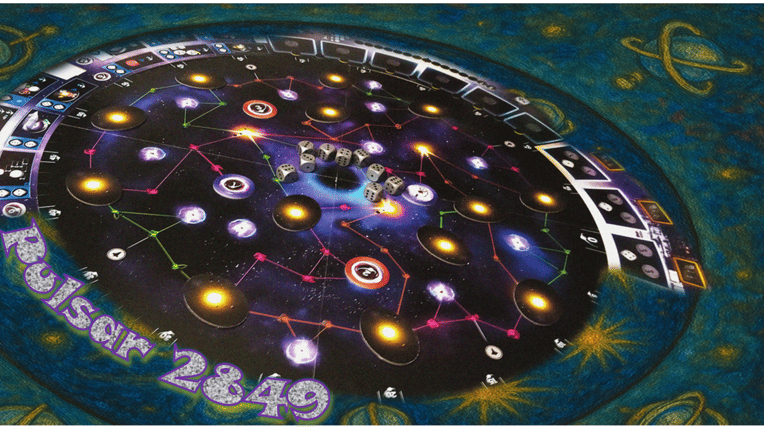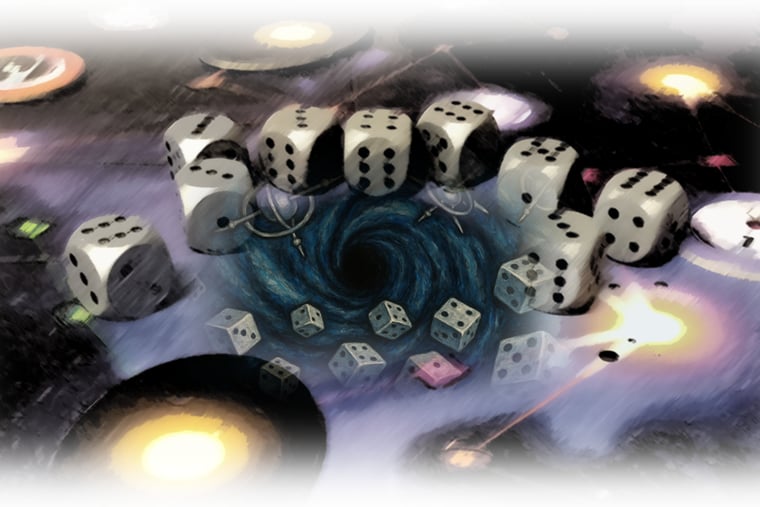Unfolding Pulsar 2849 & the Power Median
A review of Pulsar 2849
BOARDVAARK GAME REVIEW
Chris Sanderson
6/29/20254 min read


Unfolding Pulsar 2849's board was like unfolding space itself.
I could have launched myself into it.
Was it my imagination, or was this vast disc projecting itself beyond its own rim?
Solar system plates were hovering over it like fireflies over a moonlit space-lake.
A massive, neon-threaded star network was tracing sparkler patterns across that disc's galactic eyeball.
Awesome! But there was more.
On the edge, curved support boards and tracks were rippling outwards towards other galaxies.
And everywhere, dotted symbols were announcing a promised dice fest,
marking codes to unlock future powers, energy, treasures, projects.
Here was the galaxy brought to my reach, spread out for my delight.
And wordless! Not a trace of text anywhere, as if space's vacuum had swallowed all extraneous sound.
Was this possible? Could a game do such things even before it started?
Play began, and the intensity hit.
I was suddenly wading through a graviton pool,
every decision weighing a thousand kilos,
each turn like cutting through reinforced titanium,
each die activating a new portal
- and simultaneously collapsing a thousand others.
Breathless, I put my space skates on to skate the great disc pool, zig-zagging neon pathways while prising open solar systems like oysters. Energy cubes, gyrodynes and dice modifiers started piling up on my HQ board.
For what? That remained to be seen.
But my failure to activate my gyrodynes was burning holes in my conscience. Meanwhile the tech tree was opening undreamt-of triggers and combos for specialization...
But what to specialize in? That too remained to be seen.
Transmitters, those resource hunks, kept drifting by tantalizingly for a moment before entering the discard pile. I longed to clunk two together and see the offspring of their union: a rare red die for a crucial moment.
But which crucial moment? All moments were crucial.
Still though I needed to keep blazing my trail across the board, stop off at a pulsar or two to set up my gyrodyne corporation ...
And accrue energy cubes to finance end-game projects.
But how?
- That also remained to be seen.
Soon.
Before it got too late to set my gyrodynes spinning,
my HQ board humming,
a transmitter functioning,
I would specialize in something,
somehow,
sometime…
Problem was, when? Time was running out. Only three more rounds - just six dice plus any red ones I might get. It was a severe limitation, enough to suction the air out of all my plans.
Seemed like a good moment to pause, take a deep breath, make eye contact with my opponents, crack a joke and remind each other that it was just a game.
Truth was, though, we all knew it wasn't.
This was real.
We were experiencing the basic tug that is the essence of our galaxy.
You know the thing.
It's in the tide, that constant tussle of moon and ocean.
It's there in the outward-flung galaxies,
their expansionist impetus internally tethered by anchoring black holes.
Centrifugal momentum and gravity. The pull and drag of elemental forces. It's what keeps our galaxy from either tearing itself apart or imploding.
It's also what makes Pulsar 2849 work so brilliantly.
The game captures perfectly that tension between the escalating expansionist urge of limitless creative possibilities, and the imploding drag of the sheer impossibility of developing even a fraction of them.
That ‘drag’ comes from the eight-round limit and from the dice themselves.
Yes, this is a supremely dice-driven game. Which sounds like a recipe for randomness, the familiar sabotaging of all known strategies.
But these dice obey a higher rule.
The Median.
It literally holds the game together.
Imagine the game without it. An incessant hunt for high dice numbers. Imbalance, extreme disparity. No levelling mechanism. Things floating off into the outer rim.
The Median Rule saves us from all that.
These dice line up on that median track like they’re in conclave, their silverwood mystique holding a gravitational force that mesmerizes.
I can work with dice like that! I can go happily skipping along interplanetary neon pathways and cracking open solar systems with the peace of knowing that the Grand Median has the galaxy's dice-hub well under control.
Just as well that restraining order exists, because there are enough elements here to send my neural gyrodynes spinning until way past bedtime:
- Gyrodynes: as long as you’re just dabbling in them, you'll never reap their massive benefits.
- HQ board: how often have I licked my lips over those stunning top-flight perks only to realise I'll never reach them unless I go all out.
- Tech tree: you can be a bit pickier here, since each round opens fresh new dimensions to all-comers.
- Transmitters don't mind waiting a couple of rounds to be finally clunked together to grant a life-saving red die.
And all of this while we go skating across the luminescent surface of the galaxy, leaving no planetary system unturned.
At least that’s the ideal. In reality, there is too much to ‘unturn’ here. Space is too wide; the options are practically limitless. And while it’s true that other games may equally be able to pull me beyond my horizons, few do it quite so graphically - so galactically – as Pulsar 2849.


Hi, I am Chris Sanderson, an Englishman living near Madrid, Spain. Please send me your comments by email, or in BoardGameGeek through the links at the end of each game review.
© 2025. All rights reserved.